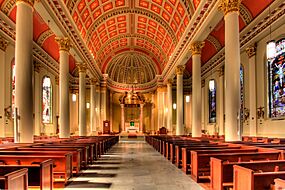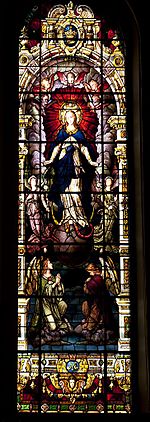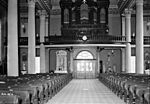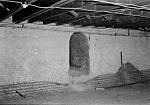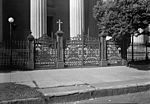Cathedral Basilica of the Immaculate Conception (Mobile, Alabama) facts for kids
Quick facts for kids Cathedral Basilica of theImmaculate Conception |
|
|---|---|
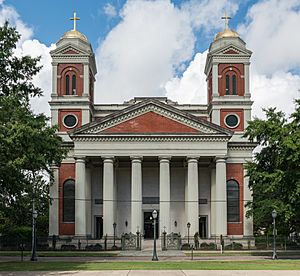 |
|
| 30°41′24″N 88°02′45″W / 30.69000°N 88.04583°W | |
| Location | 2 South Claiborne Street Mobile, Alabama |
| Country | United States |
| Denomination | Roman Catholic Church |
| History | |
| Founded | 1703 |
| Founder(s) | Most Rev. Michael Portier |
| Architecture | |
| Architect(s) | Claude Beroujon |
| Style | Greek Revival |
| Groundbreaking | 1835 |
| Completed | 1850 |
| Specifications | |
| Number of spires | Two |
| Materials | Brick |
| Administration | |
| Archdiocese | Mobile |
The Cathedral Basilica of the Immaculate Conception is a large and important Roman Catholic cathedral in Mobile, Alabama. A cathedral is the main church for a bishop in a specific area, called a diocese. This one is the main church for the Archdiocese of Mobile.
The church is named in honor of Mary, mother of Jesus, under her special title, Our Lady of the Immaculate Conception. In 1962, Pope John XXIII gave the cathedral the special title of minor basilica, which is a high honor for a church.
Contents
The Story of the Cathedral
The cathedral's parish, or local church community, is one of the oldest on the Gulf Coast. It was started way back in 1703.
The First Churches
The first church for the parish was built at a French fort called Fort Louis de la Louisiane. When the town of Mobile moved to where it is today in 1711, a new church was built. It was called Notre Dame de la Mobile, which is French for "Our Lady of Mobile."
In 1781, Spain took control of Mobile. The church was then given the name it has today: Immaculate Conception. In 1829, Bishop Michael Portier became the first bishop of Mobile. He wanted to build a grand cathedral for the growing city.
Building a Grand Cathedral
In 1833, Bishop Portier hired an architect named Claude Beroujon to design the new cathedral. The cornerstone, the first stone laid for the building, was placed in 1835. But building had to stop because of a national money crisis called the Panic of 1837.
Work finally continued, and the main part of the cathedral was finished and blessed by Bishop Portier in 1850. However, there wasn't enough money to build the front porch, called a portico, or the two tall towers.
In the 1870s, Bishop John Quinlan was able to add the beautiful front portico. It has eight huge columns in a classical style. The two towers were finally completed in 1884 under the leadership of Bishop Jeremiah O'Sullivan.
Challenges and Repairs
The cathedral has faced many challenges over the years. In 1865, right after the American Civil War, a nearby warehouse full of gunpowder exploded. The powerful blast shattered the windows on the north side of the cathedral.
In 1946, a U.S. Navy pilot's plane accidentally hit the South Tower before crashing. Then, in 1954, a fire started in the church basement and spread quickly. The fire caused a lot of damage to the inside of the church. It destroyed eight of the large stained glass windows, the bishop's chair (called a cathedra), and the pipe organ.
After the fire, Bishop Thomas Toolen led the repair efforts. The broken windows were sent to a special workshop in Germany to be fixed. A new organ was installed, and a large bronze canopy, called a baldachin, was placed over the altar.
Modern Changes and Restoration
In the 1970s, some changes were made inside the church to follow new guidelines from the Vatican. The altar was moved forward to be closer to the people. In 1979, Hurricane Frederic damaged the steeples on top of the towers.
In the 2000s, Archbishop Oscar Hugh Lipscomb started a major restoration project. The outside of the cathedral was cleaned and repaired. Inside, the floors were polished, and a beautiful new ceiling was added over the main aisle. The new ceiling has designs of the fleur-de-lis and the shamrock, which honor the French and Irish people who helped build the church community.
Cathedral Design and Features
The cathedral is located in downtown Mobile and faces east, looking toward the Mobile River. It is a very large building, measuring 164 feet long and 90 feet wide. Its two towers reach a height of 103 feet.
The building is listed on the National Register of Historic Places, which means it is recognized as an important part of American history.
Beautiful Stained Glass Windows
The cathedral is famous for its stunning stained glass windows. They were made in Munich, Germany, by the company Franz Mayer & Co. between 1890 and 1910.
Main Aisle Windows
There are twelve huge windows along the main part of the church. Each one is about 23 feet tall. They tell the story of Jesus through the eyes of his mother, Mary.
The six windows on the south wall show:
- Our Lady of the Immaculate Conception
- The Presentation of Mary at the Temple
- The Annunciation (when an angel told Mary she would be the mother of Jesus)
- The Visitation (when Mary visited her cousin Elizabeth)
- The Nativity of Jesus (the birth of Jesus)
- The Holy Family (Jesus, Mary, and Joseph)
The six windows on the north wall show:
- The Finding of the Child Jesus at the Temple
- The Marriage Feast of Cana
- The Crucifixion of Jesus
- Pentecost (when the Holy Spirit came to the apostles)
- The Assumption of Mary into Heaven
- The Coronation of Mary as Queen of Heaven
Other Special Windows
There are also large windows near the main entrance. One shows the Baptism of Jesus, and the other shows St. Cecilia, who is the patron saint of musicians. Even the doors inside the entrance have small, detailed stained glass windows.
Gallery
These photos were taken in 1936 for the Historic American Buildings Survey, showing what the cathedral looked like long ago.
See also
 In Spanish: Catedral basílica de la Inmaculada Concepción (Mobile) para niños
In Spanish: Catedral basílica de la Inmaculada Concepción (Mobile) para niños


